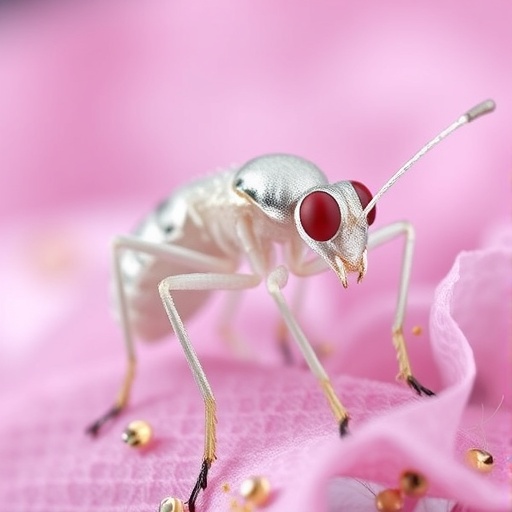In a groundbreaking study that promises to reshape our understanding of the ecological impacts of heavy metal exposure, researchers have unveiled significant findings on the effects of increased aluminum exposure on a diatom species, Entomoneis vertebralis. This innovative research was spearheaded by Ragunathan, Purdy, and Seppala, whose detailed analysis reveals dramatic alterations in crucial metabolic pathways associated with silicon, carbon, and nitrogen in these organisms. Conducted through a series of rigorous laboratory experiments, the study is poised to spark discussions about not only environmental science but also the broader implications for ecosystem health and biodiversity.
The backdrop to this research lies in the alarming rise of aluminum levels in various natural habitats due to human activities, including mining, industrial processes, and the application of aluminum-containing products. As a common metal found in the Earth’s crust, aluminum’s natural presence is exacerbated by anthropogenic actions, presenting a pressing need for scientific inquiry into its various effects on aquatic life. Notably, diatoms like Entomoneis vertebralis are keystone species in aquatic ecosystems, playing a vital role in carbon fixation and nutrient cycling, making their response to aluminum exposure of utmost significance.
The researchers meticulously designed their experiments to investigate the biological and biochemical repercussions of elevated aluminum exposure on Entomoneis vertebralis. This study focused on key metabolic pathways, honing in on the influences of aluminum on silicon, carbon, and nitrogen metabolism. Silicon is particularly critical for diatoms, which utilize it to build their characteristic silica frustules, a process intimately linked with their growth and reproduction. The study’s findings revealed that increased aluminum concentrations led to disrupted silicon assimilation, raising concerns about the ability of these organisms to maintain their structural integrity and reproductive capacity in aluminum-laden environments.
Furthermore, the implications of altered carbon metabolism cannot be understated. As diatoms serve as primary producers, any disruption in their metabolic capacity could have cascading effects throughout aquatic food webs. The research highlights an observed shift in carbon allocation within Entomoneis vertebralis, suggesting that increased aluminum may lead to reduced efficiency in photosynthesis and energy conversion. This reduced carbon fixation raises alarms about potential impacts on global carbon cycles, particularly in regions experiencing heightened aluminum deposition.
Accompanying these shifts in silicon and carbon metabolism, the study also delved into the changes within nitrogen metabolism. Nitrogen, a critical nutrient for diatom growth, is often subject to limitations in aquatic environments. The findings indicated that aluminum exposure could disrupt nitrogen uptake and assimilation pathways, potentially leading to nutrient imbalances in ecosystems heavily reliant on these microorganisms. This biochemical disruption could have severe ramifications, not just for diatoms but for the myriad of organisms that rely on them for sustenance.
The implications of this research stretch beyond theoretical boundaries, presenting a clarion call for increased monitoring of aluminum levels in aquatic ecosystems. As human influence on natural environments continues to intensify, understanding how contaminants like aluminum affect foundational species becomes paramount. The study advocates for a proactive approach in environmental policy, encouraging regulations that mitigate aluminum release into water systems. This insight could be invaluable for ecologists, environmental policy-makers, and conservationists striving to protect aquatic ecosystems from the adverse effects of metal contamination.
Moreover, the findings contribute significantly to the broader discourse on climate change and environmental degradation. As global temperatures rise, the ability of ecosystems to adapt to changing conditions is put to the test. This research underscores the vulnerability of marine and freshwater ecosystems to the combined stressors of climate change and pollution. Understanding the nuanced interactions between chemical pollutants and essential ecosystem processes, as demonstrated through the metabolic alterations in Entomoneis vertebralis, is crucial for our efforts to foster resilience in the face of rapid environmental changes.
The technology employed in this research is noteworthy, employing advanced genomic techniques to ascertain the metabolic pathways affected by aluminum exposure. By utilizing state-of-the-art sequencing methods alongside biochemical assays, the researchers were able to provide a comprehensive view of metabolic changes at the molecular level. This methodological approach not only enhances the reliability of their findings but also paves the way for future investigations into other pollutants that may affect diatomic communities and their responses to environmental stressors.
As the scientific community digs deeper into the responses of Entomoneis vertebralis to aluminum exposure, this research potentially sets the stage for further interdisciplinary work examining the consequences for broader biogeochemical cycles. Collaborations between ecologists, chemists, and environmental scientists could yield valuable insights into how microscopic organisms mediate responses to environmental change and pollution. Understanding these mechanisms is crucial for predictions about ecosystem sustainability and resilience amidst anthropogenic pressures.
In conclusion, the comprehensive research conducted by Ragunathan and colleagues serves as an integral piece of the puzzle in understanding the environmental impacts of aluminum exposure. Their findings shed light on the complex biochemical landscapes navigated by diatoms, emphasizing the need for sustainable practices that protect these vital organisms. Ultimately, as we delve deeper into the interconnectedness of our ecosystems, it becomes increasingly evident that maintaining the health of foundational species like Entomoneis vertebralis is essential for the broader health of our planet.
Science has a unique role in transforming our understanding of ecological issues, and this study exemplifies the need for rigorous inquiry in the face of pressing environmental challenges. The findings call for immediate attention and action—ensuring that the lessons gleaned from such research translate into meaningful policies and practices aimed at preserving our vital aquatic ecosystems for generations to come.
Subject of Research: The effects of aluminum exposure on silicon, carbon, and nitrogen metabolism in Entomoneis vertebralis.
Article Title: Increased aluminum exposure induces widespread changes in silicon, carbon, and nitrogen metabolism in Entomoneis vertebralis.
Article References:
Ragunathan, R., Purdy, H.M., Seppala, S. et al. Increased aluminum exposure induces widespread changes in silicon, carbon, and nitrogen metabolism in Entomoneis vertebralis.
BMC Genomics 26, 926 (2025). https://doi.org/10.1186/s12864-025-12106-7
Image Credits: AI Generated
DOI: 10.1186/s12864-025-12106-7
Keywords: Aluminum exposure, Entomoneis vertebralis, silicon metabolism, carbon metabolism, nitrogen metabolism, diatoms, aquatic ecosystems, environmental pollution, metabolic pathways.




